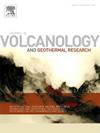在斯特龙博利大爆炸之前,火山气体的变化在统计上是显著的
IF 2.3
3区 地球科学
Q2 GEOSCIENCES, MULTIDISCIPLINARY
Journal of Volcanology and Geothermal Research
Pub Date : 2025-03-25
DOI:10.1016/j.jvolgeores.2025.108325
引用次数: 0
摘要
通常情况下,基性的、开放的火山活动是温和的,但偶尔会有突然的、比正常情况更大的爆发。这些突然的岩浆爆炸事件的例子是在意大利的斯特龙博利火山发生的所谓的“大爆炸”(平均每年2到4次)。这些相对较小的爆炸(火山爆炸指数,VEI <;1)在地表活动没有明显前兆变化的情况下发生,因此对火山学家/监测人员构成威胁,在最严重的情况下对人口构成威胁。过去的研究发现,火山气体羽流中二氧化碳/二氧化硫高比率的时期与此类爆炸的发生之间存在联系,但这种联系从未得到统计证实。在此,我们报告了在斯特龙博利火山4年(2020 - 2023)活雪期记录的火山气体羽流中CO2和SO2的浓度和稀释羽流的比例,以及SO2通量的测量,在此期间发生了22次这样的大爆炸。使用条件Logit模型和接收者工作特征(ROC)分析,我们建立了火山羽流中主要爆炸的发生与二氧化硫浓度(非常显著)和通量降低以及二氧化碳/二氧化硫比(显著)高的时期之间的统计关联。这些发现是根据一个简化的概念模型来解释的,该模型解释了大爆炸是由流变不连续处的气泡积聚引起的,这是由提供“规则”斯特龙堡活动的浅层对流岩浆减速造成的。利用统计分析的结果,我们开发了一个基于火山气体的复合指标,该指标成功地预测了71%的时间尺度为周(s)的事件(通过后验分析)。然而,我们发现这个综合指标与大(32%)假阳性率相关,因此精度低(20%)。so2浓度在模型中的显著作用表明,为了提高该方法的预测性能,可能需要考虑其他因素,如羽流方向和陨石坑间气体组成的变化。因此,虽然我们的研究结果强调了气体羽流观测在火山监测中的重要性,但它们也强调了它们作为火山喷发预测工具目前的局限性。本文章由计算机程序翻译,如有差异,请以英文原文为准。
Volcanic gas changes prior to Stromboli's major explosions are statistically significant
The generally mild activity of mafic, open-vent volcanoes is punctuated by the periodic occurrence of sudden, larger-than-normal explosive eruptions. Examples of these sudden mafic explosive events are the so-called “major explosions” that occur (2 to 4 times a year on average) at Stromboli volcano in Italy. These relatively small explosions (Volcanic Explosivity Index, VEI < 1) occur without no obvious precursory change in surface activity, and therefore pose a threat to volcanologists/monitoring staff, and to the population in the most severe cases. Past work has found a link between periods of high CO2/SO2 ratios in the volcanic gas plume and the occurrence of such explosions, but this association has never been statistically verified. Here, we report on nearly continuous observations of volcanic gas plume CO2 and SO2 concentrations and ratios in a diluted plume, as well as SO2 flux measurements, recorded in a four year (2020 to 2023) activity period of Stromboli volcano, during which 22 such major explosions took place. Using the Conditional Logit model and the Receiver Operating Characteristic (ROC) analysis, we establish a statistical association between the occurrence of major explosions and periods of reduced SO2 concentrations (very significant) and fluxes, and high CO2/SO2 ratios (significant), in the volcanic plume. These findings are interpreted in light of a simplified conceptual model that explains major explosions as caused by gas bubble accumulation at a rheological discontinuity, resulting from deceleration of the shallow convecting magma that supplies the “regular” Strombolian activity. Using results of statistical analysis, we develop a volcanic gas-based Composite indicator that successfully forecasts (by a-posteriori analysis) 71 % of the events on timescales of week(s). However, we find that this Composite indicator is associated with a large (32 %) False Positive rate and hence low precision (20 %). The significant role of SO₂ concentrations in the model indicates that other factors, such as plume direction and inter-crater variations in gas composition, may need to be taken into account for improving the forecasting performance of the method. Thus, while our results emphasize the importance of gas plume observations in volcano monitoring, they also highlight their current limitations as eruption forecasting tools.
求助全文
通过发布文献求助,成功后即可免费获取论文全文。
去求助
来源期刊
CiteScore
5.90
自引率
13.80%
发文量
183
审稿时长
19.7 weeks
期刊介绍:
An international research journal with focus on volcanic and geothermal processes and their impact on the environment and society.
Submission of papers covering the following aspects of volcanology and geothermal research are encouraged:
(1) Geological aspects of volcanic systems: volcano stratigraphy, structure and tectonic influence; eruptive history; evolution of volcanic landforms; eruption style and progress; dispersal patterns of lava and ash; analysis of real-time eruption observations.
(2) Geochemical and petrological aspects of volcanic rocks: magma genesis and evolution; crystallization; volatile compositions, solubility, and degassing; volcanic petrography and textural analysis.
(3) Hydrology, geochemistry and measurement of volcanic and hydrothermal fluids: volcanic gas emissions; fumaroles and springs; crater lakes; hydrothermal mineralization.
(4) Geophysical aspects of volcanic systems: physical properties of volcanic rocks and magmas; heat flow studies; volcano seismology, geodesy and remote sensing.
(5) Computational modeling and experimental simulation of magmatic and hydrothermal processes: eruption dynamics; magma transport and storage; plume dynamics and ash dispersal; lava flow dynamics; hydrothermal fluid flow; thermodynamics of aqueous fluids and melts.
(6) Volcano hazard and risk research: hazard zonation methodology, development of forecasting tools; assessment techniques for vulnerability and impact.

 求助内容:
求助内容: 应助结果提醒方式:
应助结果提醒方式:


